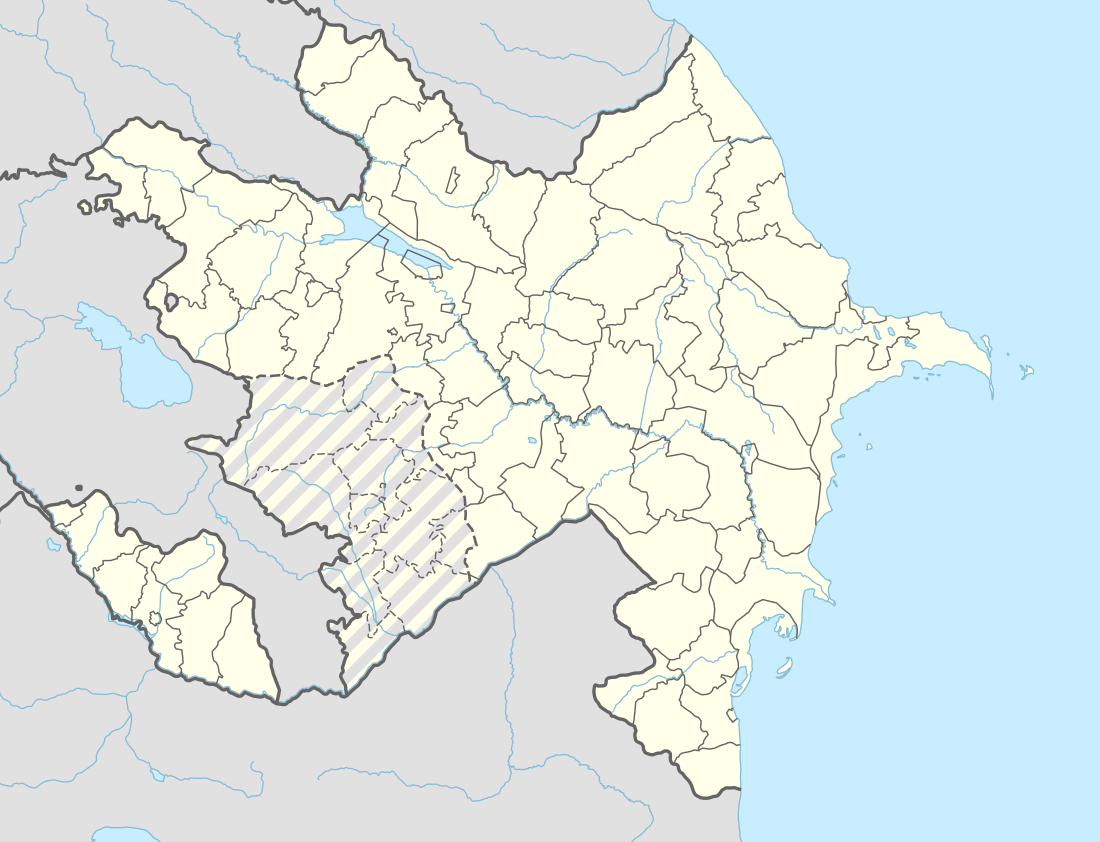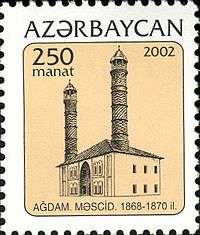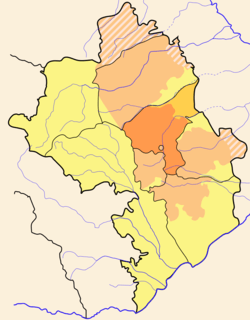Agdam
Ağdam (also spelled Agdam or Aghdam) is a ghost town in the southwest part of Azerbaijan and the formal capital of its Agdam District, today controlled by the de facto Republic of Artsakh, but de jure internationally recognized territory of the Republic of Azerbaijan.[1] Founded in the early 19th century, it grew considerably during the Soviet period and had 28,000 inhabitants by 1989. Armenian forces captured Agdam in July 1993 during the Nagorno-Karabakh War.[2] The heavy fighting forced the entire population to flee eastwards. Upon seizing the city, Nagorno-Karabakh Republic (NKR) forces destroyed much of the town to discourage Azerbaijanis from returning. More damage occurred in the following decades when locals looted the abandoned town for building materials. It is currently almost entirely ruined and uninhabited.[3] According to the United Nations Security Council's resolution #853 that 'Demands the immediate cessation of all hostilities, calls on withdrawal of Armenian troops from Agdam and other recently occupied areas of the Azerbaijani Republic and reaffirms UN Resolution 822'.
Ağdam Ակնա, Akna | |
|---|---|
 Ağdam Ակնա, Akna | |
| Coordinates: 39°59′35″N 46°55′50″E | |
| Country | |
| Rayon | Agdam |
| Elevation | 369 m (1,211 ft) |
| Time zone | UTC+4 |
| • Summer (DST) | UTC+5 |
In November 2010 it was renamed by the NKR government to Akna (Armenian: Ակնա).[4][5] It is administratively part of the town of Askeran, which is located some 10 km away.[6]
Etymology
The city's name is of Azerbaijani origin and means "white house", where ağ means "white" and dam is "house" or "attic", thus referring to a "bright sun-lit, white house" which was given by Panah Ali Khan of the Karabakh Khanate.[7] Another possibility is that it was derived from ancient Turkic glossary meaning "small fortress". In the distant past, Turkic speaking tribes built small fortresses for their protection and safety.[7]
History

Agdam was founded in the 18th century and granted city status in 1828.[8] It is 26 km (16 miles) from Stepanakert (Khankendi). Before the Nagorno-Karabakh War, butter, wine and brandy, machine factories and a railway station functioned there.[9][10]
Nagorno-Karabakh War

Agdam was the scene of fierce fighting during the Nagorno-Karabakh War. According to journalist Robert Parsons, Azerbaijani forces used Agdam as a base for attacks on Karabakh, launching BM-21 Grad rockets and bombing raids from there against civilians.[11] [12] As the city fell, almost its entire population fled eastward.[13]
The Armed Forces of Armenia still use the city as a buffer zone, meaning that Ağdam remains empty and decaying, and usually off-limits for sightseeing.[14][15]
Post-war years
The ruined city once had a population of almost 40,000 people,[16] but today it is an almost entirely uninhabited ghost town.[17] All the houses are ruined, some by shells fired in the war, others due to looting for building materials.[18][19]
According to unverified Azeri sources one of the buildings to be stripped of materials is the Agdam Mosque, which has been converted into a barn for cattle and pigs. Its derelict condition, including a missing roof, drew criticism from Azerbaijani and Turkish communities, who wrote a letter in 2010 to Pope Benedict XVI asking him to warn Armenians (though Armenians predominantly follow a church which broke with Rome in the 6th century) about the situation.[20]
Geography
Climate
| Climate data for Agdam | |||||||||||||
|---|---|---|---|---|---|---|---|---|---|---|---|---|---|
| Month | Jan | Feb | Mar | Apr | May | Jun | Jul | Aug | Sep | Oct | Nov | Dec | Year |
| Average high °C (°F) | 6.2 (43.2) |
7.0 (44.6) |
11.2 (52.2) |
18.6 (65.5) |
23.1 (73.6) |
27.8 (82.0) |
31.3 (88.3) |
30.1 (86.2) |
25.9 (78.6) |
19.1 (66.4) |
13.0 (55.4) |
8.6 (47.5) |
18.5 (65.3) |
| Daily mean °C (°F) | 2.3 (36.1) |
2.8 (37.0) |
6.1 (43.0) |
12.3 (54.1) |
16.1 (61.0) |
20.4 (68.7) |
24.6 (76.3) |
23.3 (73.9) |
18.6 (65.5) |
13.5 (56.3) |
8.2 (46.8) |
4.1 (39.4) |
12.7 (54.9) |
| Average low °C (°F) | −0.9 (30.4) |
0.0 (32.0) |
3.2 (37.8) |
8.9 (48.0) |
13.5 (56.3) |
17.8 (64.0) |
21.2 (70.2) |
20.0 (68.0) |
16.4 (61.5) |
10.6 (51.1) |
5.8 (42.4) |
1.5 (34.7) |
9.8 (49.6) |
| Average precipitation mm (inches) | 15 (0.6) |
24 (0.9) |
32 (1.3) |
48 (1.9) |
73 (2.9) |
64 (2.5) |
33 (1.3) |
27 (1.1) |
30 (1.2) |
50 (2.0) |
32 (1.3) |
19 (0.7) |
447 (17.6) |
| Average precipitation days | 4 | 6 | 7 | 7 | 10 | 7 | 3 | 3 | 4 | 6 | 5 | 4 | 66 |
| Source: NOAA[23] | |||||||||||||
Demographics
| Year | Population | Ethnic groups | Source |
|---|---|---|---|
| 1923 | 1,660 | [24] | |
| 1926 | 7,910 | 93.6% Azeri | Soviet census[25] |
| 1939 | 10,746 | 83.3% Azeri, 8.7% Russian, 5.3% Armenian | Soviet census[26] |
| 1959 | 16,061 | 92% Azeri, 3.6% Russian, 3.4% Armenian | Soviet census[27] |
| 1970 | 21,277 | 94.9% Azeri, 2% Russian & Ukrainian, 2% Armenian | Soviet census[28] |
| 1979 | 23,483 | 97% Azeri, 1.3% Russian & Ukrainian, 1.2% Armenian | Soviet census[29] |
| 1989 | 28,031 | Soviet census[30] | |
| 1991 | 39,200 | [24] | |
| 2005 | 0 | NKR census[24] | |
| 2010 | 360 | NKR census[31] | |
Economy
Culture
Music and media
Mugham music, a tradition in the Karabakh region, is an important part of Agdam's musical heritage; the city was home to Agdam Mugham School, which produced "Karabakh nightingales" ensemble.[32][33]
Sport
Despite the invasion, the town is represented by a professional association football team competing in the top-flight of Azerbaijani football – Qarabağ FK, currently playing in the Azerbaijan Premier League.[34]
The Imarat Stadium, which was Agdam's only stadium, was also destroyed by bombardments from Armenian military forces during the Nagorno-Karabakh War.[35][36][37]
Transport
Education
Notable residents
Some of the city's notable former residents include military commanders Allahverdi Bagirov and Asif Maharammov, footballers Ramiz Mammadov, Mushfig Huseynov and Vüqar Nadirov, mugham singers Gadir Rustamov, Mansum Ibrahimov and Sakhavat Mammadov, actor Jeyhun Mirzayev, scientist Zakir Mammadov and singer Roya.
See also
References
- Gai︠a︡nė Novikova (2004). The Nagorno Karabakh Conflict: In Search of the Way Out : To the Question of the Readiness of Azerbaijani and Armenian Societies to a Compromise Resolution of the Conflict. Amrots Group. p. 138.
- "Caucasus City Falls to Armenian Forces". The New York Times. 24 August 1993.
In July, Armenian forces forced out the defenders of Agdam, Azerbaijan.
- Specter, Michael (2 June 1994). "Azerbaijan, Potentially Rich, Is Impoverished by Warfare". The New York Times.
Cities like Agdam have been emptied of people.
- "Armenian separatists rename Azeri town". azernews.az. 3 November 2010.
- "July 23 marks 21st anniv. of Akna (Aghdam) liberation". PanARMENIAN.Net. 23 July 2014.
- Musayelyan, Lusine (26 April 2011). "Life Among Ruins of Caucasus' Hiroshima". Institute for War and Peace Reporting.
- "Agdam city". Ministry of Culture and Tourism of Azerbaijan. Archived from the original on 20 July 2012. Retrieved 26 July 2010.
- Значение слова "Агдам" в Большой Советской Энциклопедии (in Russian). Soviet Encyclopedia. Retrieved 26 July 2010.
- Агдам (Азербайджан). Landmarkers.ru (in Russian). Archived from the original on 9 March 2012. Retrieved 26 July 2010.
- Girchenko, Yuriy. Юрий Гирченко. В Союзе все спокойно... (in Russian). Retrieved 26 July 2010.
- Parsons, Robert (3 June 2000). "Tug-of-war for Nagorno-Karabakh". BBC News. Archived from the original on 27 April 2010. Retrieved 26 July 2010.
- Human Rights Watch. Azerbaijan: Seven years of conflict in Nagorno-Karabakh. p.19.
- Paul, Amanda. "Agdam – an Azerbaijani ghost town". Archived from the original on 19 May 2011. Retrieved 18 May 2011.
- Hannigan, Chris. "Ghost Towns: Ağdam, Azerbaijan". Archived from the original on 13 August 2010. Retrieved 26 July 2010.
- Chauffor, Célia. "Report: Agdam, ghost city". Caucaz Europenewz. Archived from the original on 1 July 2010. Retrieved 26 July 2010.
- "Azerbaijani cities".
- "20 Abandoned Cities from Around the World". Daily Cognition. Retrieved 26 July 2010.
- Esslemont, Tom (25 June 2009). "Karabakh guns still at the ready". BBC News. Retrieved 21 February 2018.
- Armenians occupied Agdam cities listed among the ghosts Archived 2011-07-06 at the Wayback Machine
- "Turks complain to Pope on vandalism in Karabakh mosque by Armenians". Archived from the original on 20 July 2010. Retrieved 26 July 2010.
- Lonely Planet Georgia, Armenia & Azerbaijan (Travel Guide). Lonely Planet Publications. 2008. p. 301.
- "Dark Tourism's Agdam". dark-tourism.com. Retrieved 14 November 2014.
- "Agdam Climate Normals 1961–1990". National Oceanic and Atmospheric Administration. Retrieved 22 March 2015.
- "Azərbaycan". pop-stat.mashke.org.
- "Агдамский уезд 1926". ethno-kavkaz.narod.ru.
- "Агдамский район 1939". ethno-kavkaz.narod.ru.
- "Агдамский район 1959". ethno-kavkaz.narod.ru.
- "Агдамский район 1970". ethno-kavkaz.narod.ru.
- "Агдамский район 1979". ethno-kavkaz.narod.ru.
- "Archived copy". Archived from the original on 2014-02-22. Retrieved 2014-06-03.CS1 maint: archived copy as title (link)
- "Новости-ARMENIA Today-Карабах: Агдам переименован в Акна". armtoday.info. Retrieved 2017-09-26.
- Shirinov, Elnur. ""Qarabağ bülbülləri" nin yaradıcısı kimdir". Retrieved 14 November 2014.
- Золотой голос Карабаха – Гадир Рустамов. karabakhinfo.com (in Russian). Archived from the original on 22 December 2015. Retrieved 14 November 2014.
- Adil Nadirov: «Bizi az qala döyüb öldürəcəkdilər" Archived 2016-03-19 at the Wayback Machine (20 April 2010) (in Azerbaijani)
- Vaxt olmayan yer (in Azerbaijani) Archived July 6, 2011, at the Wayback Machine
- Ermənilərin xarabaya çevirdiyi Ağdamın «İmarət» stadionu Archived 2016-03-22 at the Wayback Machine (8 June 2010) (in Azerbaijani)
- “Caqa” ikinci dəfə lotereyada uddu (in Azerbaijani) Archived July 6, 2011, at the Wayback Machine
External links
| Wikimedia Commons has media related to Agdam. |
| Wikivoyage has a travel guide for Agdam. |
- Aghdam: This is no Hiroshima
- Fleeing from Aghdam. Refugee poem
- World Gazetteer: Azerbaijan– World-Gazetteer.com
- Pictures of the deserted town: "Abandoned War-Torn City of Agdam, Azerbaijan"
- Pictures of the deserted town: "Aghdam"
- "Clashes Intensify Between Armenia and Azerbaijan Over Disputed Land". The New York Times. January 31, 2015.

.svg.png)
